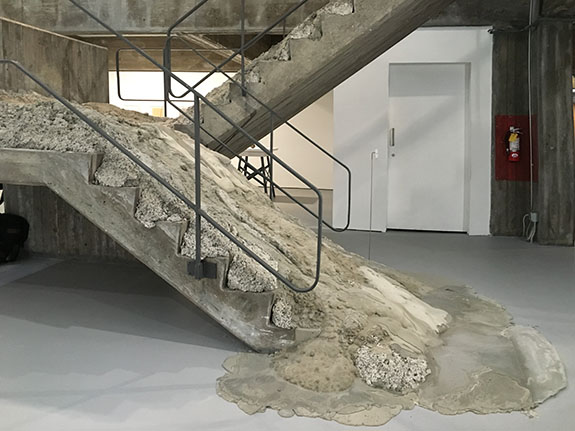 |
.jpg) |
In the decades that followed, Ireland executed still other architectural excavations as well as commissions, installations, sculptures and performances. But 500 Capp remains his magnum opus, the yarn out of which all of subsequent visions spun, and which today stands as a milestone of West Coast Conceptualism, a movement that remains, to this day a strong influence on artists everywhere. A synthesis of Duchamp, Arte Povera and Fluxus, it sought answers to basic questions: What function should art serve and how it might it produce something more meaningful than just mantelpiece objects of consumer desire and social status?
 |
 |
 |
his immediate peers, assistants and others who, in varying degrees, felt his influence. Problem is, Ireland’s works come close to overshadowing everyone else’s. How could they not? If artlessness and a rejection of conventional aesthetic strategies are, to Ireland’s way of thinking, measures of value, then few artists beyond his immediate circle measure up. Two that do are Charlie Casteneda and Brody Reiman, the duo known professionally as Casteneda/Reiman. For years, mostly under the radar, they’ve been making spectacular work by combining drywall fragments with mass-produced landscape paintings – sometimes displayed as-is, at other times partially occluded by paint, while at still other times photographically transferred onto hard surfaces and printed across multiple planes, at different depths. At first glance they look like piles of refuse. Close inspection reveals them to be meticulous trompe l’oeil sculptures. They confuse interior and exterior, and evince a keen appreciation for all that can be wrung from building materials. The untitled landscape they have on view here does this with vertical bands of drywall set against a concave backdrop, with photographic images run across multiple planes, making it difficult to differentiate real space from illusionistic space. Ireland, I’m guessing, would have approved.
.jpg) |
 |
In a related vein, Paul Kos addressed the art vs. money issue with a poster detailing a series of transactions that reads like a recipe for an elaborate shell game – one in which it’s unclear whether money or goods actually change hands or whether anyone profits. It’s called Quid Pro Quo (1970), and it’s displayed, appropriately, next to a gold pan with a bit of gold leaf at the bottom. Together the two could easily serve as a manifesto representing Conceptualism’s disdain for the market.
.jpg) |
photo of the front door of the Museum of Conceptual Art, the institution he founded in 1970 and ran until 1984. The image, from 1975, looks old and faded, but it’s really the decrepit condition of the building – the peeling paint, the missing door lock and the punched-out mail slot — that makes it look that way. You could write it off as slum-chic. But it goes further, deeper. Reflected in the window are several layers of history: the nose of a ’69 Pontiac, a parking lot that is now Yerba Buena Gardens and, in the background, St. Patrick’s Church, a structure that dates to the Gold Rush. Like Ireland’s house at 500 Capp, Marioni’s picture represents a time capsule of a vanished era – not an attempt to affect a dilapidated look (Beech) or repurpose Ireland’s signature materials and methods (Hidalgo). Two nearby collections of condiments and cosmetic containers, assembled by Nayland Blake, further illustrate this point. Their contents long ago decayed, and thus, have become putridly discolored. But in Ireland’s scheme of things, that sort of ugliness was always a virtue, a starting point for finding meaning in what is and what was and for locating your own position within your own environment, however you choose to define it. In working through that process Ireland and his circle discovered and made art.